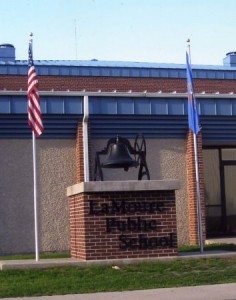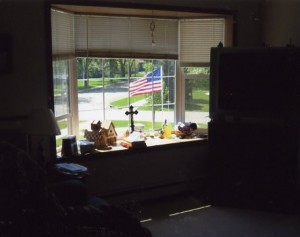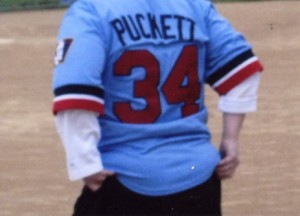We had our breakfast in the hotel in Krakow the morning of May 4, 2000. We’d been together, the 40 of us**, since April 26, but this day was even more serious than most earlier days had been, and those days had been serious, too: Tabor, Terezin, Prague…. There was not much small talk this day.
We boarded the bus and travelled west out of Krakow towards the Polish town of Brzezinka, 40 miles away. Near Brzezinka we gathered in a parking lot, and entered a place called Auschwitz, filing under the archway with the infamous words “Arbeit Macht Frei“. For us, roughly half and half Christian and Jew, this was not the first visit to a place of the horrors of the Holocaust – there had been several stops before today – but for most of us it was probably the most powerful single event.
May 4 also happened to be my 60th birthday.
As Spring days go, May 4, 2000, was ideal. The trees had leafed out; it was bright sun. But there is something about spending a pleasant day in a place like Auschwitz….
Brzezinka (Oswiecm to the Germans) was actually home to two of the three places in the Auschwitz group. Auschwitz I, where we went under the arch, was basically for Polish prisoners of the Reich.
We spent some somber time there, then it was time for Auschwitz II, a place called Birkenau, where between 1.1 and 1.5 million Jews perished between 1943 and its liberation January 27, 1945.
It is about 1 1/2 miles between Auschwitz I and Birkenau, and we requested and received permission to walk between the two places, most of the route along the same railroad track which transported the Jews to their death. It was a time of pretty intense introspection, there was no frivolity on that walk. For almost all the Jews who entered Birkenau, there was no exit.

A quiet walk on a beautiful day May 4, 2000
I guess you could say that we “toured” Birkenau, but somehow that word doesn’t fit.
We saw the ruins of the ovens which, they said, could efficiently cremate 4415 bodies a day, but which often incinerated twice as many.
In the afternoon, in a pleasant glade between the ruins of the crematory ovens, there was a memorial service. The youngest of our group, and me, the birthday boy, were chosen to light candles to the memory of those who had died in the holocaust. Two of the photos, here, are at that place.
It was a beautiful afternoon, the birds were chirping in the trees surrounding us. Somehow it didn’t match the black and white images of the camp when its sole function was to kill Jews. May 4, 2000, is one of those days whose memory will never leave me.
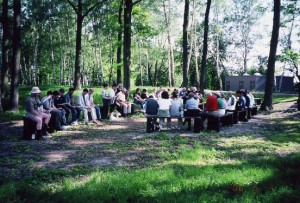
We’re now 10 years from that day in 2000. Another ten years have passed.
May 4, 2000, was 16 months before 9-11-01 and all that has transpired since that time.
Our group stayed in touch for awhile, but it has been a long time since there was any real contact. Such is how things go, even when you’re together in intense experiences as we were.
Entering the first museum building at Auschwitz one’s eyes encounter George Santayana’s famous quotation: “
those who cannot remember the past are condemned to repeat it“.
I would like to propose a corollary to all of us: it is not enough to simply remember the past, unless one learns from it for the future, and diligently applies the learnings.
Remembering is not enough.
At night, back at the hotel, I mentioned to the group that my Uncle Frank Bernard was among the first American casualties of WW II, on the USS Arizona at Pearl Harbor, December 7, 1941. In that awful war, WWII, it is said that at least
50,000,000 ultimately perished because of the war. Six million were Jews*. Another nearly six million were Poles.
The records show that the official beginning of the German surrender to the allies began 65 years ago today, May 4, 1945. It would be early September before the Japanese surrendered. Another uncle, my mother’s brother, Navy officer George Busch, was aboard Destroyer DD460 which docked at Tokyo the evening of September 10, 1945.
Until we become more proficient at making Peace than we are at making War; at being friends than being enemies; all is ultimately lost….
I wish I could be hopeful.
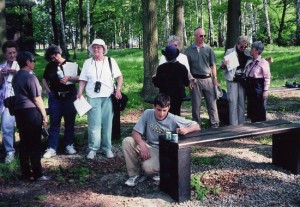
Ben and the Memorial Candles within Birkenau
* One of the prayers at Auschwitz, May 4, 2000:
Reader: Silence. Only silence. Waiting for our reply. All of them, waiting. Three million and three hundred thousand Jews lived in Poland before the war.
Congregation: Three million died.
Reader: Two million eight hundred and fifty thousand Jews lived in Russia.
Congregation: More than a million died.
Reader: One and a half million Jews lived in the Balkans and Slavic countries.
Congregation: More than a million died.
Reader: Germany, Austria, France and Italy had six hundred and fifty thousand Jews.
Congregation: Half of them died.
Reader: Rhodes and Cyprus had happy, thriving congregations.
Congregation: The synagogues stand empty now.
Reader: Our brothers and sisters were murdered everywhere in the days of destruction.
Congregation: They died in cities and towns, in villages and fields.
Reader: They died in the night and the fog, they died between dawn and dusk.
Congregation: They died by fire and water, by poison and gun.
Reader: They died alone; but we will not forget them.
Congregation: They died alone; but we will not forget them.
Reader: We will remember them; in reverence, and in silence.
** – We were a delegation from
Temple Israel and
Basilica of St. Mary in Minneapolis MN. To my knowledge (I haven’t checked, lately), Temple and Basilica were the first, and probably remain the only, joint Christian and Jew plaque on the remembrance wall at the U.S. Holocaust Memorial Museum in Washington, D.C. That is a testimony to the friendship of Rabbi Joseph Edelheit and Fr. Michael O’Connell.
Postscript June 30, 2010: Note this link:
A powerful photo album from Auschwitz with pictures taken when the death camp at Birkenau was in operation..
Here’s a more recent photo album, including photos taken by our fellow pilgrim on our visit to Auschwitz and other places of the Holocaust in April and May 2000. Note #3.

